display FIAT 500E 2014 2.G User Guide
[x] Cancel search | Manufacturer: FIAT, Model Year: 2014, Model line: 500E, Model: FIAT 500E 2014 2.GPages: 363, PDF Size: 2.66 MB
Page 144 of 363

WARNING!
•Drivers must be careful when backing up even
when using the Rear Park Assist system. Always
check carefully behind your vehicle, look behind
you, and be sure to check for pedestrians, animals,
other vehicles, obstructions, and blind spots before
backing up. You are responsible for safety and
must continue to pay attention to your surround-
ings. Failure to do so can result in serious injury or
death.
(Continued)
WARNING! (Continued)
•Before using the Rear Park Assist System, it is
strongly recommended that the ball mount and
hitch ball assembly is disconnected from the ve-
hicle when the vehicle is not used for towing.
Failure to do so can result in injury or damage to
vehicles or obstacles because the hitch ball will be
much closer to the obstacle than the rear fascia
when the warning display turns on the single
flashing arc and sounds the continuous tone. Also,
the sensors could detect the ball mount and hitch
ball assembly, depending on its size and shape,
giving a false indication that an obstacle is behind
the vehicle.
(Continued)
142 UNDERSTANDING THE FEATURES OF YOUR VEHICLE
Page 145 of 363

Failure Indications
A malfunction of the Rear Park Assist sensors or system
is indicated, during REVERSE engagement, by the instru-
ment panel warning icon.The warning icon is illuminated and a message
is displayed on the multifunction display (if
equipped). Refer to “Instrument Cluster De-
scriptions” in “Understanding Your Instrument
Panel” for further information.
The sensors and wiring are tested continuously when the
ignition is in the ON/RUN position. Failures are indi-
cated immediately if they occur when the system is ON. Even if the system is able to identify that a specific sensor
is in failure condition, the instrument cluster display
shall indicate that the Rear Park Assist system is unavail-
able, without reference to the sensor in failure condition.
If even a single sensor fails, the entire system must be
disabled. The system is turned off automatically.
NOTE:
The instrument cluster will NOT display any
message if the bumper sensors are dirty.
3
UNDERSTANDING THE FEATURES OF YOUR VEHICLE 143
Page 164 of 363
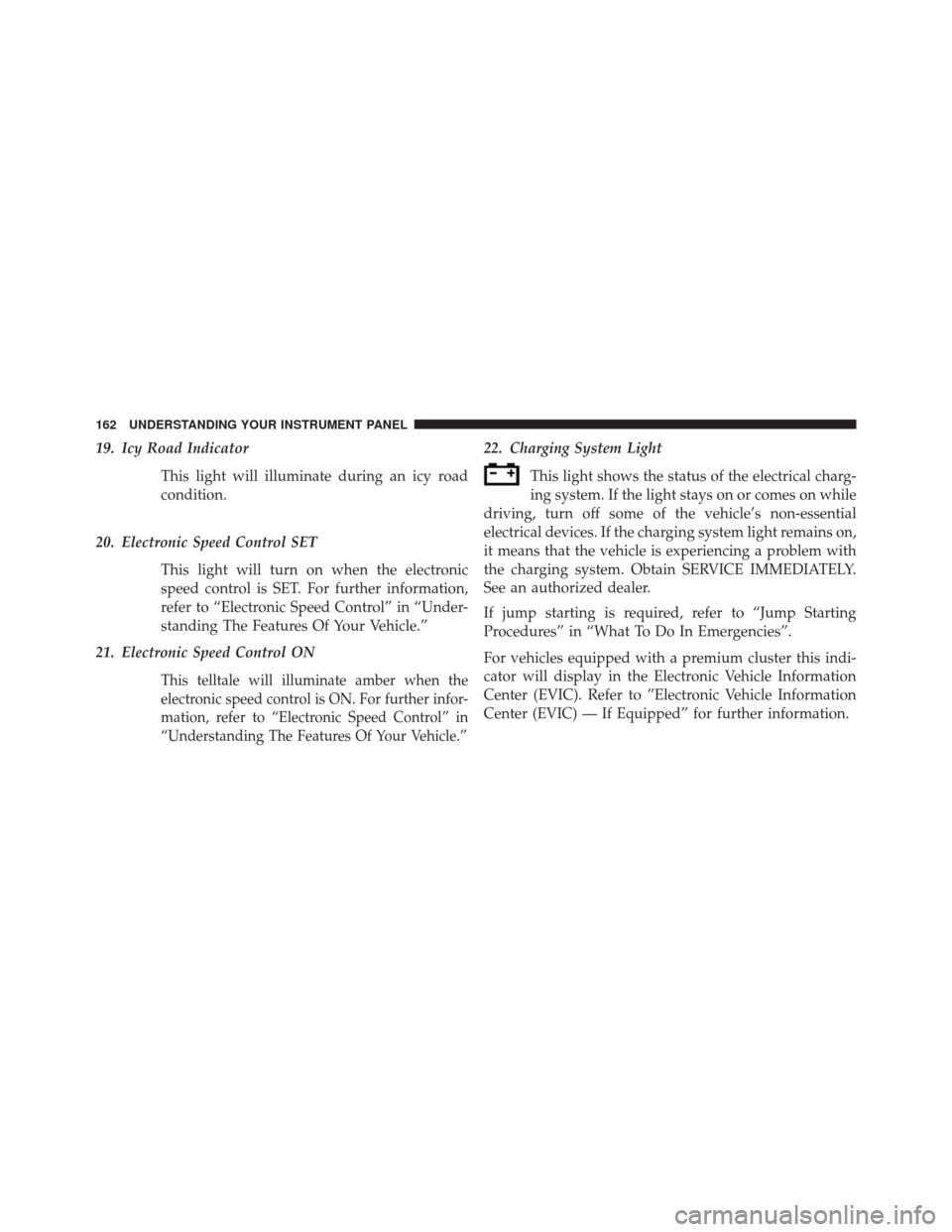
19. Icy Road IndicatorThis light will illuminate during an icy road
condition.
20. Electronic Speed Control SET This light will turn on when the electronic
speed control is SET. For further information,
refer to “Electronic Speed Control” in “Under-
standing The Features Of Your Vehicle.”
21. Electronic Speed Control ON
This telltale will illuminate amber when the
electronic speed control is ON. For further infor-
mation, refer to “Electronic Speed Control” in
“Understanding The Features Of Your Vehicle.”
22. Charging System Light
This light shows the status of the electrical charg-
ing system. If the light stays on or comes on while
driving, turn off some of the vehicle’s non-essential
electrical devices. If the charging system light remains on,
it means that the vehicle is experiencing a problem with
the charging system. Obtain SERVICE IMMEDIATELY.
See an authorized dealer.
If jump starting is required, refer to “Jump Starting
Procedures” in “What To Do In Emergencies”.
For vehicles equipped with a premium cluster this indi-
cator will display in the Electronic Vehicle Information
Center (EVIC). Refer to ”Electronic Vehicle Information
Center (EVIC) — If Equipped” for further information.
162 UNDERSTANDING YOUR INSTRUMENT PANEL
Page 167 of 363

CAUTION!
The TPMS has been optimized for the original
equipment tires and wheels. TPMS pressures and
warning have been established for the tire size
equipped on your vehicle. Undesirable system opera-
tion or sensor damage may result when using re-
placement equipment that is not of the same size,
type, and/or style. Aftermarket wheels can cause
sensor damage. Do not use tire sealant from a can or
balance beads if your vehicle is equipped with a
TPMS, as damage to the sensors may result.
ELECTRONIC VEHICLE INFORMATION CENTER
(EVIC)
The Electronic Vehicle Information Center (EVIC) fea-
tures a driver-interactive display that is located in the
instrument cluster.The EVIC consists of the following:
•
System Status
• Vehicle Information Warning Message Displays
• Outside Temperature Display
Electronic Vehicle Information Center (EVIC) Display
4
UNDERSTANDING YOUR INSTRUMENT PANEL 165
Page 168 of 363
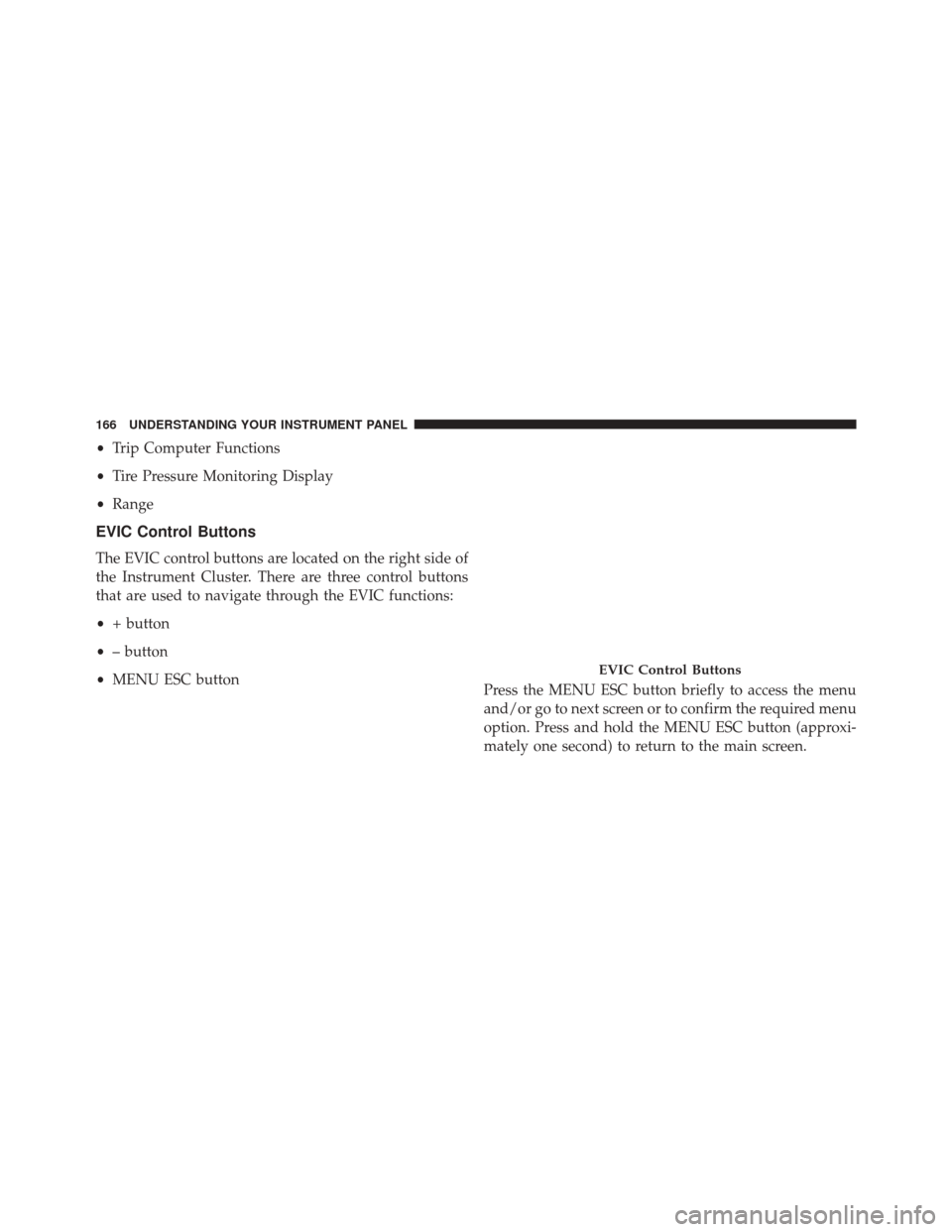
•Trip Computer Functions
• Tire Pressure Monitoring Display
• Range
EVIC Control Buttons
The EVIC control buttons are located on the right side of
the Instrument Cluster. There are three control buttons
that are used to navigate through the EVIC functions:
•+ button
• – button
• MENU ESC button
Press the MENU ESC button briefly to access the menu
and/or go to next screen or to confirm the required menu
option. Press and hold the MENU ESC button (approxi-
mately one second) to return to the main screen.
EVIC Control Buttons
166 UNDERSTANDING YOUR INSTRUMENT PANEL
Page 169 of 363
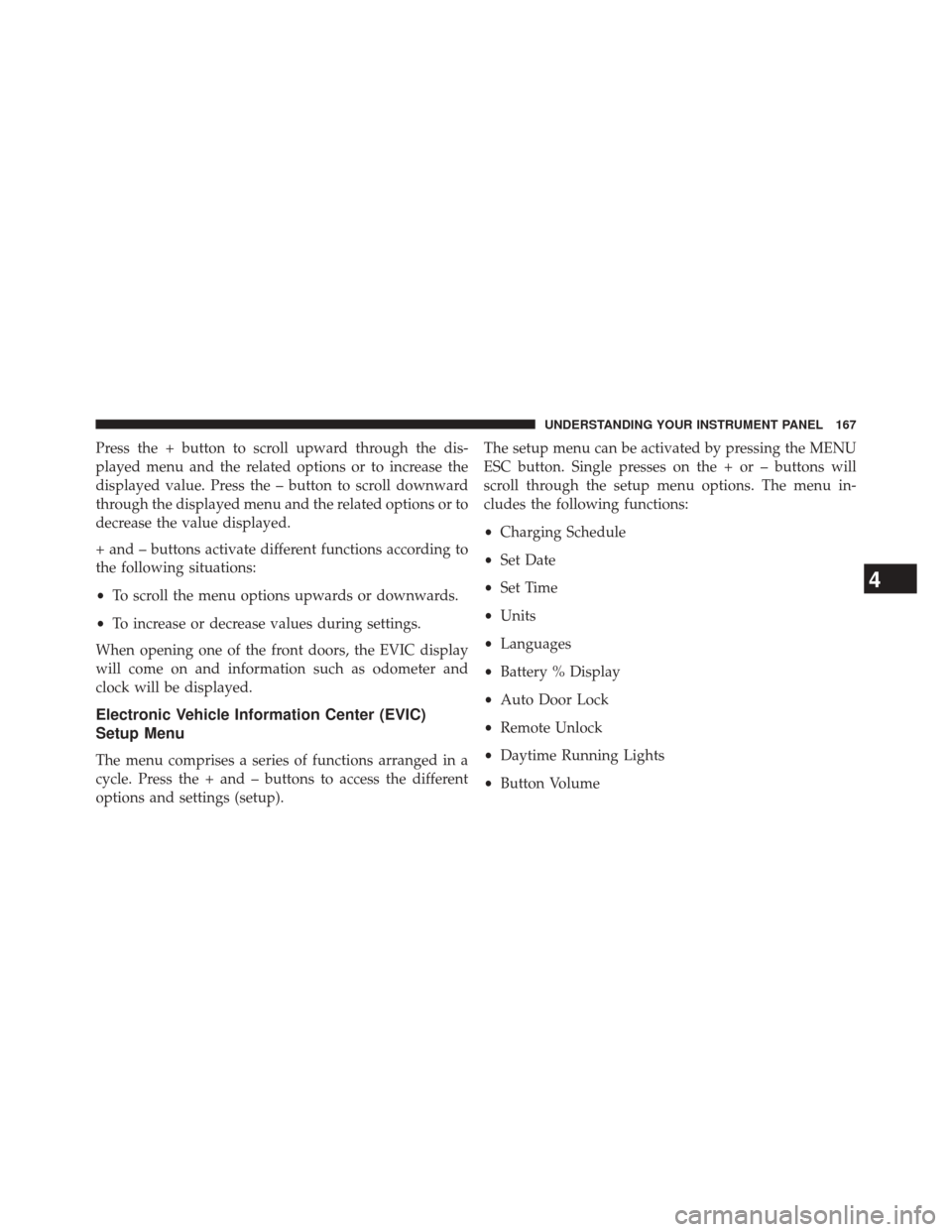
Press the + button to scroll upward through the dis-
played menu and the related options or to increase the
displayed value. Press the – button to scroll downward
through the displayed menu and the related options or to
decrease the value displayed.
+ and – buttons activate different functions according to
the following situations:
•To scroll the menu options upwards or downwards.
• To increase or decrease values during settings.
When opening one of the front doors, the EVIC display
will come on and information such as odometer and
clock will be displayed.
Electronic Vehicle Information Center (EVIC)
Setup Menu
The menu comprises a series of functions arranged in a
cycle. Press the + and – buttons to access the different
options and settings (setup). The setup menu can be activated by pressing the MENU
ESC button. Single presses on the + or – buttons will
scroll through the setup menu options. The menu in-
cludes the following functions:
•
Charging Schedule
• Set Date
• Set Time
• Units
• Languages
• Battery % Display
• Auto Door Lock
• Remote Unlock
• Daytime Running Lights
• Button Volume
4
UNDERSTANDING YOUR INSTRUMENT PANEL 167
Page 170 of 363
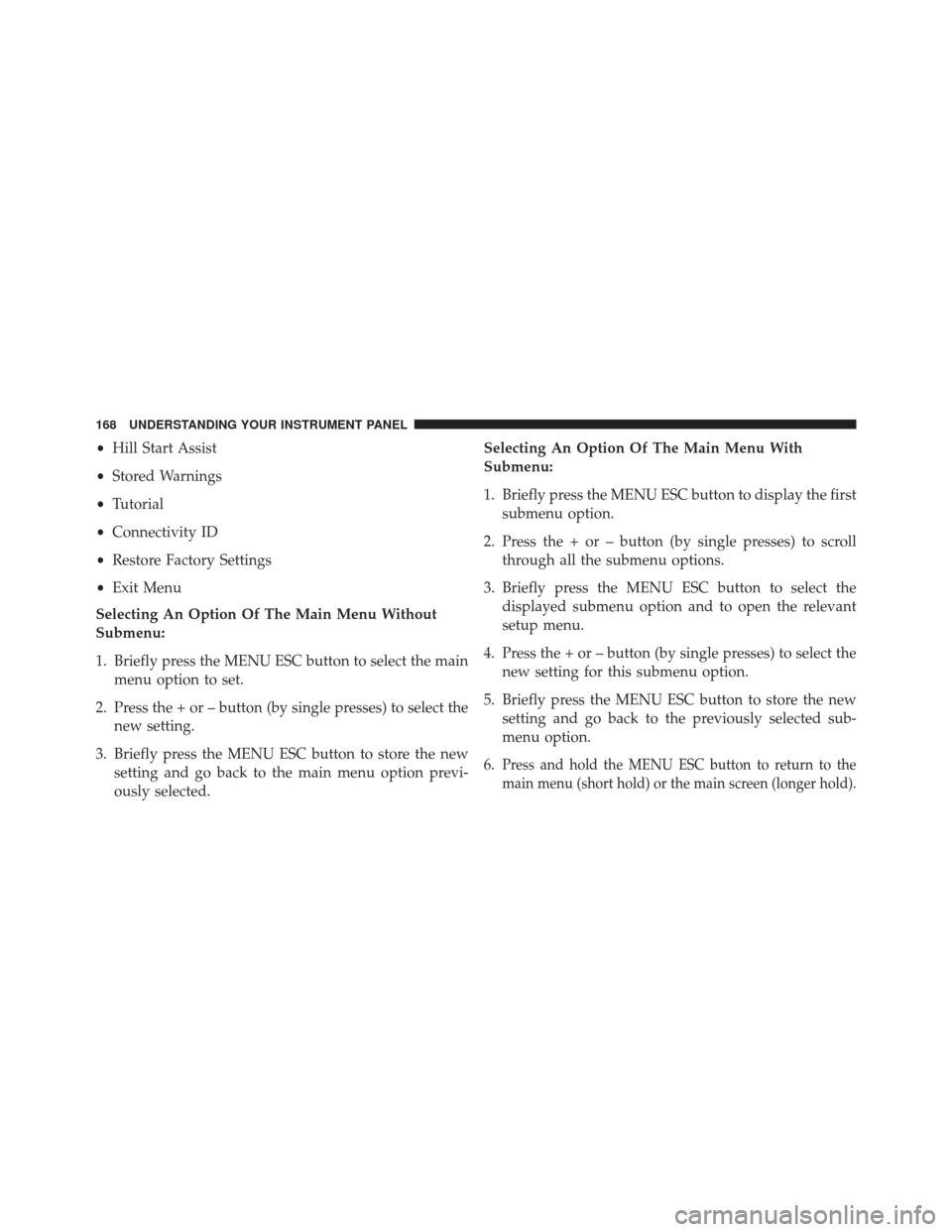
•Hill Start Assist
• Stored Warnings
• Tutorial
• Connectivity ID
• Restore Factory Settings
• Exit Menu
Selecting An Option Of The Main Menu Without
Submenu:
1. Briefly press the MENU ESC button to select the main menu option to set.
2. Press the + or – button (by single presses) to select the new setting.
3. Briefly press the MENU ESC button to store the new setting and go back to the main menu option previ-
ously selected. Selecting An Option Of The Main Menu With
Submenu:
1. Briefly press the MENU ESC button to display the first
submenu option.
2. Press the + or – button (by single presses) to scroll through all the submenu options.
3. Briefly press the MENU ESC button to select the displayed submenu option and to open the relevant
setup menu.
4. Press the + or – button (by single presses) to select the new setting for this submenu option.
5. Briefly press the MENU ESC button to store the new setting and go back to the previously selected sub-
menu option.
6.
Press and hold the MENU ESC button to return to the
main menu (short hold) or the main screen (longer hold).
168 UNDERSTANDING YOUR INSTRUMENT PANEL
Page 171 of 363

Trip Computer
The Trip Computer is located in the instrument cluster.
The Trip Computer displays trip information such as:
average speed, distance traveled, average energy, time
traveled, motor power, and tire pressure.
Trip Button
TheTRIP button, located on the right steering column
stalk.
•A short button press scrolls through the user-selectable
information.
• A long button press resets.
The User-Selectable options are:
• Motor Power (Kilowatts)
• Trip A
Trip Button
4
UNDERSTANDING YOUR INSTRUMENT PANEL 169
Page 172 of 363
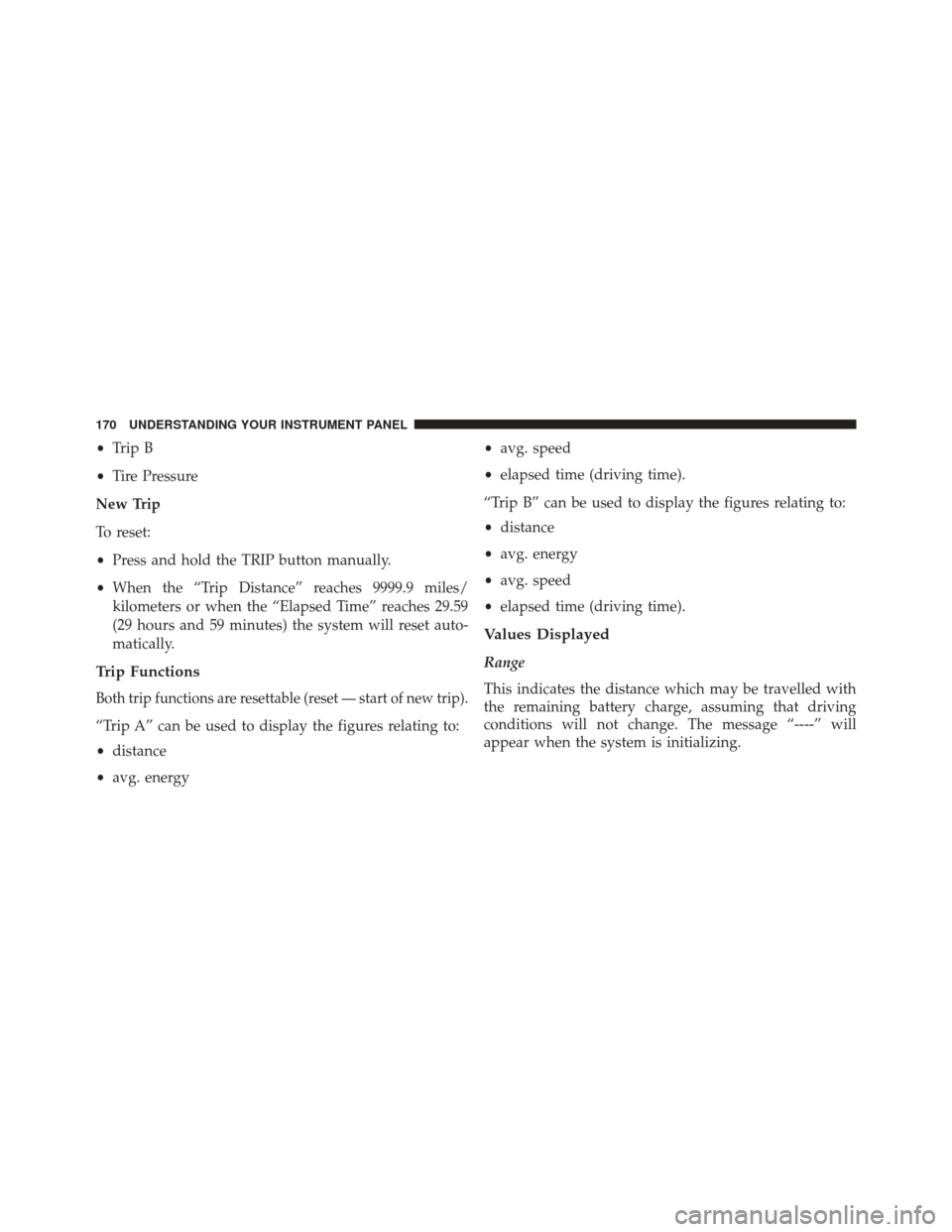
•Trip B
• Tire Pressure
New Trip
To reset:
• Press and hold the TRIP button manually.
• When the “Trip Distance” reaches 9999.9 miles/
kilometers or when the “Elapsed Time” reaches 29.59
(29 hours and 59 minutes) the system will reset auto-
matically.
Trip Functions
Both trip functions are resettable (reset — start of new trip).
“Trip A” can be used to display the figures relating to:
• distance
• avg. energy •
avg. speed
• elapsed time (driving time).
“Trip B” can be used to display the figures relating to:
• distance
• avg. energy
• avg. speed
• elapsed time (driving time).
Values Displayed
Range
This indicates the distance which may be travelled with
the remaining battery charge, assuming that driving
conditions will not change. The message “----” will
appear when the system is initializing.
170 UNDERSTANDING YOUR INSTRUMENT PANEL
Page 180 of 363

General Information
The radio offers the following functions:
Radio Section
•PLL tuning with FM/AM bands
• RBDS (Radio Broadcast Data System)
• Automatic/manual station tuning
• FM Multipath detector
• Manual storing of 25 stations (base radio) and 40
stations (if equipped with Satellite): 15 on FM band
(5 on FMA, 5 on FMB, 5 on FMC), 10 on AM band (5 on
AMA, 5 on AMB), 15 on Satellite Band - if equipped
(5 on SATA, 5 on SATB, 5 on SATC)
• SPEED VOLUME function: Customer selectable auto-
matic volume adjustment depending on the car speed
• Automatic Stereo/Mono selection
CD Section
•Track selection (forward/backward)
• Fast forward/rewind through tracks
• CD Display function: display of track number and on
mp3 discs (song title, artist) and time elapsed since
start of the track
• Playing Audio CD, CD-R and CD-RW
WARNING!
On multimedia CDs, besides audio tracks, there are
data tracks too. Playing this type of CD could cause
hissing at a volume that could jeopardize road safety
as well as causing damage to the speakers.
178 UNDERSTANDING YOUR INSTRUMENT PANEL